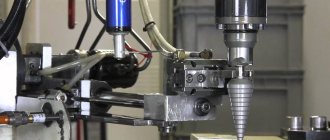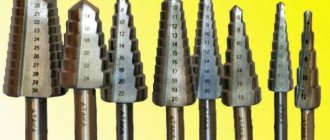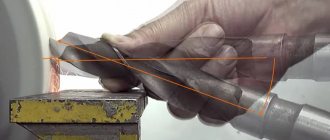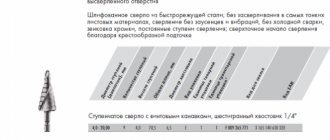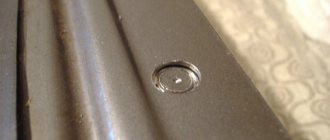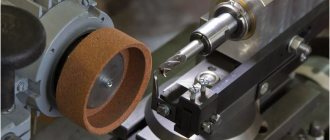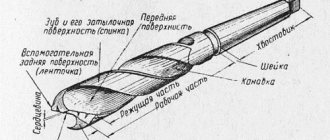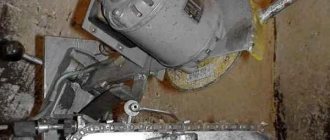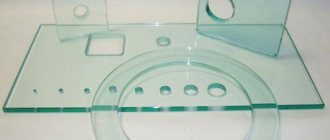[A step drill for metal] can also be called a cone drill; the tool received the first version of its name due to its appearance.
Each of its steps, formed due to a smooth spiral transition, has its own diameter, which allows you to determine during the drilling process what size the hole currently has.
At the same time, novice craftsmen have a poor idea of why step drills are needed, if there are a great variety of different devices that allow you to make any hole in metal.
Many may think that buying a step drill is a waste of money, especially since the price for this category of tools is quite high.
To dispel unnecessary doubts, let’s consider what advantages a cone product has and in what cases it can be used.
Which step drills for metal are best to choose?
To make a high-quality hole in metal, you need to select a drill that will cope with this task. If you need to perform high-precision work in sheet material up to 4 mm thick, then a step drill for metal will be most suitable for this. Such cutting products not only have increased accuracy, but also require the correct approach to the drilling operation.
To process the material correctly, you need to know some of the nuances of selecting and using such a tool. All the intricacies of metal processing using cone drills will be discussed in detail below.
How to sharpen a step drill with your own hands
Long-term use of a gimlet causes it to become dull. This makes it necessary to have information on how to sharpen it correctly. Although this is not an easy procedure, if you have reliable information and skills, everything will work out.
The procedure for sharpening a cone drill requires the following sequence of actions:
- secure the gimlet with a vice;
- install a grinding wheel on the grinder;
- Being careful, sharpen the cutting edges that have been damaged.
There are several options for sharpening a step drill. For example:
- Single-plane. This type of sharpening is used to sharpen tools whose thickness does not exceed 3 mm. During the sharpening process, it is recommended to attach the tool to the sharpening wheel, moving the gimlet along the wheel. It is worth noting that using this type of sharpening may cause slight damage to the cutting edge of the drill.
- Conical. Recommended for sharpening gimlets with a length of 3 mm or more. While working, it is recommended to lightly press the drill onto the circle and carefully move it along the work surface.
- Finishing. Used to correct small errors and inaccuracies that have arisen after sharpening. For work you should take a soft sharpening stone.
Sharpening step drills yourself requires excellent lighting, vision and accuracy.
Homemade sharpening devices
If you do not have the appropriate machine, you can sharpen it using other devices. We are talking about an electric drill or homemade equipment created according to a drawing
. It's best to give preference to the second option, otherwise you may ruin a lot of drills before you master proper sharpening.
You can even create a suitable device with your own hands from wood. So, a beam with holes corresponding to the diameter of the drills is fixed on a horizontal surface. The holes mentioned above are made at a slight angle to obtain the required sharpening angle.
Some craftsmen prefer an electric drill equipped with appropriate attachments. Naturally, the range of such elements is small
, which makes it difficult to do the sharpening yourself. As a rule, a stone and a leash are included with the nozzles. If you plan to sharpen drill bits using a specific drill, you should immediately shorten the driver.
If you wish, you can make a similar attachment for a drill yourself, following the recommendations given in the corresponding video. Such devices must be equipped with fasteners for fixing the drill.
Design and characteristics of a cone-step drill
These instruments have a rather complex design. Their configuration may differ depending on the variety. Let us consider in more detail what parts such products consist of. The top of the drill is represented by a pointed tip, which makes it possible to cut into metal of any density without much difficulty.
Other tools are also used for processing metal sheets, for example, crown tools. A metal drill of this type does not require the use of auxiliary centering devices, but it is not suitable for working with thin metal. Spiral analogues also do not allow such work to be performed accurately.
Step products are very effective when working with aluminum, steel, copper and other sheets and pipes. Tools of this type are shaped like a cone, which includes 2 grooves. They promote drilling of materials. During operation, when moving to the next level, a chamfer is formed for the hole that is created by the previous step.
Due to their design, step drills are suitable for working with copper, steel and aluminum sheets
A 4-32 mm step drill for metal also has an opposite end, which is mounted in the tool chuck. The opposite end, or tail, has the most suitable design for this and consists of six edges. The advantages of such tools are undeniable, which is why many craftsmen recommend them for working with metal parts.
Key Features and Applications
The design consists of a working part made of tool steel and a shank. The working surface of step and cone drills for metal is formed by a groove running along a sharp tip in the form of a stepped or smooth cone, respectively. The diameter of the section is marked along the length of the barrel - using the marks, the size of the hole to be made is determined. These cutters can be used to drill through metal no more than 6 millimeters thick, wood, drywall, plastic, fiberglass, etc.
When using a conical drill for metal, burrs do not appear, so the holes do not need to be further processed with a needle file or grinder. The sharp tip eliminates the need for a centering tool and makes it possible to drill into high-density metal. There are also models with an additional layer of abrasive coating, which increases the strength of the edges and extends the service life of the product.
Step drills are used in car repair, construction, laying utility networks, and installing plumbing equipment. Installed on machines, special two-handed drills of pneumatic and electric type, on conventional drills with reliable fixation of the part (otherwise the tool will jam).
Advantages of cone drills
Stepped products have the following positive properties:
- allow you to make a hole with smoother edges compared to spiral and feather counterparts;
- For holes of different diameters, one step drill is used;
- perfectly centers the hole;
- used for processing very thin sheet metal;
- ideal for processing non-ferrous metals;
- for large volumes of work, it saves time due to the absence of the need to frequently replace drills of different diameters.
A step drill allows you not only to perform high-quality drilling of metals, but also to correct hole defects that were made with other types of products. For example, if the center of the hole is displaced when using spiral analogues, a conical one can completely correct the defect.
It is also possible to expand the holes if necessary to a fixed diameter. Despite the higher cost of cone drills, significant savings can be achieved with frequent use. Due to the absence of the need to purchase a large number of tools of different diameters.
A cone drill allows you to chamfer during drilling and therefore does not require additional time, which saves time during large volumes of work.
Features and benefits of using cone drills
The cutting edges of the stepped device have a high strength index, which ensures a long working life.
Unlike conventional metal drills, a step tool allows you to perform a number of jobs that would otherwise require the use of a litany of other tools.
It is precisely because of this versatility that the price of step drills is too high.
The second advantage of using a drilling product is the drilling speed, at which the quality of the edge is not reduced even for thin sheet metal.
In addition to metal, using conical devices, you can work with drywall, wood, plastic and other materials.
Dense metal is also not a problem that a step drill can't handle.
Its sharp tip easily cuts into a metal product with the densest structure. In this case, there is no need to use a centering element, which simplifies the working action.
The unique design of conical products makes it possible to eliminate the use of an angle grinder and a needle file, and, if necessary, polish the finished hole.
The translational channels of the device differ in size and have a smooth transition of 35-450, which in turn increases the efficiency of drilling work with thin metal by 50%.
In addition, their design helps to enhance the cutting properties of the tool and at the same time ensures its smooth operation when processing metal.
This attachment can be used for both automated and manual devices.
The abrasive coating gives the cone product special strength.
It can be made of diamond or titanium chips, thanks to which there is no need to frequently sharpen the product under normal load conditions.
The price of cone drills for metal depends on the diameter of their working part and the type of spraying; at the moment it can range from 2 thousand to 5 thousand rubles.
The easiest way to solve the problem of “ragged” holes, which can have different configurations, is to use a step metal drill.
With the correct diameter of the tool, you can improve any unsuccessful attempt to make a hole.
In addition, a cone drill is indispensable when working with thin sheet metal, fiberglass and plastic products.
Therefore, a step drill can be called a device “for all occasions”; it is good to have for specialists in various workshops, installers and home craftsmen.
In our video you can see how to use this tool.
Checking the sharpness of the drill
After a visual inspection shows that the cutting edges are smooth and sharp, check whether the correct sharpening angle of the metal drill is maintained and whether the length of the working edges meets the standards. To evaluate, you will need a special template, a protractor or protractor, and a caliper.
Checking the length of the cutting edges with a caliper
What parameters need to be checked?
- Is the angle of the cutting edge tilted forward? The presence of such an error makes the cutting edge not the highest point of the tooth and forms a hill on the back surface. This causes the drill bit to rub against the back surface of the material and not drill. The error is corrected by sharpening the drill again.
- Are the lengths of the cutting edges consistent from the center point on the web to the side apexes of the cutting edges? This distance must be the same on both sides, otherwise the diameter of the final hole will be larger than the nominal value.
- Check that the apex angle is 120°. You can determine the sharpening angle of a metal drill using a purchased or homemade template. It is important to ensure that the apex angles match for both teeth, otherwise only one side will work.
Correct and incorrect sharpening of a drill
After checking the basic parameters, drill into any metal workpiece. If the sharpening is done correctly, the drill will smoothly enter the metal, and the chips will evenly exit the grooves on both sides. And the finished hole will exceed the nominal diameter by no more than 0.05–0.1 cm.
After drilling the workpiece, sharpen the jumper to reduce the force applied during operation and reduce tool wear.
How to make a template for checking drill sharpness?
A template for checking the sharpening of a metal drill can be made independently from sheet steel or tin. You can take a template from the store as a guide. The simplest template can be made from two or three nuts. Nuts are ideal for these purposes, as they are regular hexagons with internal angles of 120°. If the nuts are connected, the angle between their faces will also be 120°. The nuts can be welded or glued to each other using hot glue.
Video description
The video shows how the master made a device that helps to properly sharpen a drill for metal:
How to sharpen a drill using a drill
If a sharpening machine is not available, you can adapt a drill with a grinding wheel mounted on the shaft. There are two options for the process:
- hold the drill in a vice and bring the drill to the stone with your hands;
- Clamp the cutting tool in a vice and bring the stone with the drill manually.
Both options are not easy, but the second is easier than the first.
How to sharpen a drill correctly in this case:
- the cutting tool must be installed in a vice in a vertical position;
- using a circle mounted on a drill, the trailing edge is removed, the goal is to remove signs of wear;
- then sharpening is carried out at the required angle - usually 120°.
Attention! To prevent the edge from overheating, the sharpening process should be carried out for no more than two seconds. That is, the metal is removed in layers.
But there is an easier way. To do this, you need to purchase a special nozzle. It is installed on a drill and a drill is inserted into a special groove. The latter, relative to the rotating sharpening tool, is located at a certain angle equal to the sharpening angle. This can be clearly seen in the photo below.
Sharpening a drill using a drill and a special attachment Source yandex.net
Manufacturers of step drills
Products made in China are of low quality (there are exceptions). To buy a good cone drill, you should pay attention to tools made in Europe and Russia.
1. “Zubr” - stepped drills from a domestic manufacturer are of reasonable cost. The quality is at a fairly high level.
Cone drills can be made from ordinary tool steel or coated with more wear-resistant alloys. In the latter case, the price will be significantly higher, but the quality of the cutting surface will remain sharp longer even when performing a large volume of work.
2. “Attack” - Russian-made conical drills, which in quality and cost are not inferior to the best products from foreign companies.
Reviews about the products of this company are only positive, so you don’t have to worry about the quality, and in order not to overpay, you should select a tool taking into account the maximum diameter that will be needed in the work.
3. “Bosch” - the products of this German company are excellent for professionals and for working with metal at home.
The diameters on the tool are marked using a laser system, so in case of long-term use, the inscriptions are not erased. To increase the drilling speed, the top of the Bosch step drill is sharpened crosswise, and the workpiece is ground in both the transverse and radial directions.
Such processing of the tool allows, when using it, to obtain a high-quality hole, the diameter of which will fully correspond to the stage of the product.
4. “Falon-Tech” - drills from a German company have an additional titanium coating, which allows you to increase the tool life by more than 2 times.
The product has a laser marked diameter and a standard shank that is ideal for use with a screwdriver or hand drill.
Despite the increased quality of the product, its cost remains low. If you need to purchase a cone drill for home use, then the choice of products from this company is the most optimal.
All of these cutting tools do an excellent job of drilling metal up to 4 mm thick. If you need to work with thicker metal, it is recommended to use core drills.
Using machines at home
As mentioned earlier, it is advisable to use household machines at home. With their help, it is possible to sharpen various types of drills. It is important to remember that for some varieties you will have to purchase the appropriate circles.
To sharpen a drill yourself, you should give preference to a machine equipped with a universal chuck. It allows you to clamp elements of various diameters.
Often included are:
- keys;
- collets;
- spare parts;
- lamp for the work area.
The most popular equipment is from Drill Doctor and GS. Similar products are designed for sharpening drills with a diameter of 2–13 mm and 14–34 mm. Unfortunately, this equipment does not allow sharpening very thin drills. For this purpose you will have to purchase a special machine.
All equipment designed for sharpening drills at home has a number of advantages:
- possibility of working from the mains;
- high performance;
- ease of use;
- functionality;
- sharpening accuracy;
- affordable price;
- compact dimensions;
- light weight;
- convenient control system, thanks to which you can adjust the intensity of sharpening and its speed.
How to drill correctly
If you have a sharp tool, you can drill a hole in a metal workpiece no more than 4 mm thick. For proper operation, it is recommended to follow the following sequence of actions:
- Mark the location where the hole needs to be drilled using a core.
- During drilling, the tool must be held perpendicular to the working surface of the metal workpiece.
- The grinder (screwdriver) should operate at low speeds. Their value depends on the diameter: with increasing diameter, the rotation speed of the tool decreases.
- As a result of drilling, the operating temperature of the working surface increases. To reduce it, it is recommended to use a thin layer of oil to lubricate the tool.
Violation of the operating procedure can lead to its rapid dulling.
It is important not only to adhere to the recommendations for using the tool, but also to choose it correctly. The quality of a drill largely depends on the color of the metal from which it is made. For example:
- Steel with a hint of grey. This indicates that the finished tool has not been subjected to heat treatment. Such a gimlet will not last long.
- Black. After manufacturing, the drill was processed using hot steam. Thanks to this, the strength of the metal also increases.
- Golden. This color of the gimlet means that the metal is free from tension. This increases its quality and strength.
- Bright golden. This color indicates a high level of wear resistance. When creating such a tool, a metal containing titanium nitride impurities is used. They are characterized by high cost and long service life.
With proper use and selection of a stepped gimlet, the tool will serve correctly and for a long time.
How to choose a drill
Before deciding how to sharpen a drill correctly, I would like to dwell a little on the cutting tool itself.
Let's start with the fact that drills on the construction tools market are presented in a fairly wide range. Since we are only interested in metal equipment, it should be noted that there is a choice here too.
First, you can select by tool color:
- Black is an oxide film, the function of which is to protect the base of the drill from corrosion and high temperatures. Therefore, this variety has high strength and wear resistance.
- Gray – this tool can easily be classified as low quality equipment.
- Bright golden. This color indicates only one thing – the steel from which the tool is made contains titanium.
- Dark golden. The same as the previous option, only there are no internal stresses inside the steel rod. Hence its high qualities.
Types of metal drills Source rozetka.com.ua
It should be noted that most metal drills are rods made of tool steel. But to increase their cutting performance, you need to strengthen the cutting edge. Therefore, today you can buy four types of equipment with different coatings:
- Still the same black oxide film.
- TiCN is titanium carbonitride.
- TiAIN is titanium aluminum nitride.
- Titanium nitride itself.
- Ceramics.
Attention! The last two coatings cannot be re-sharpened.
Mainly in everyday life, and many craftsmen use twist drills to drill holes in metal. This is a steel cylindrical rod in which grooves are cut in the form of a spiral. Hence, in principle, the name.
The smaller part of this tool is occupied by the shank, which is clamped in the chuck of drilling equipment or in a drill or hammer drill. The main part is occupied by a cylinder with grooves. Grooves are cut for one purpose - to create a space through which metal shavings will leave the drilling site without interfering with the main process.
Twist drill: its parts and elements Source studfile.net
Spiral equipment also has a small classification, where there are three positions:
- Classic drill.
- Left-handed. It is used when it is necessary to drill out a broken fastening element from a hole: a bolt, a screw, etc.
- High precision. If the task is to drill a hole with minimal errors, then use it.
So, having sorted out the assortment of equipment, we move directly to the main question - how to sharpen a drill for metal.
Characteristics of brands
You should purchase products from trusted stores, giving preference to well-known brands. The quality of steel in cheap no-name drills may not correspond to reality, and dubious stores often sell banal counterfeits at an inflated price. Recommended brands for purchase:
- German: Falon Tech, Karnasch, Ruko, Topcraft;
- Polish: Geko;
- Russian: Attack, Globus;
- Ukrainian: Lezo, Zubr.
Thanks to careful quality control in European factories, Polish and German tools are more efficient and durable, although they are more expensive. Drills from the countries of the former USSR are a compromise between price and quality, but when choosing them you need to make sure that the quality of the metal complies with GOST. It is recommended to refrain from purchasing suspiciously cheap Chinese products.
How to extend the life of a drill
To ensure less wear on the drill, you must follow some operating rules.
- Do not overheat the drill. To do this, work at intervals and use coolant.
- Set the correct rotation speed. It is set taking into account the type and diameter of the drill, as well as the material.
- Remove the chips. Periodically remove the drill from the hole and remove the chips so that it does not get stuck in the workpiece.
- Drill holes in several approaches. If you need to make a hole with a diameter of more than 6 mm, use drills of different sizes (from larger to smaller), this will guarantee higher accuracy.
Which step drills for metal are best to choose?
To make a high-quality hole in metal, you need to select a drill that will cope with this task. If you need to perform high-precision work in sheet material up to 4 mm thick, then a step drill for metal will be most suitable for this. Such cutting products not only have increased accuracy, but also require the correct approach to the drilling operation.
To process the material correctly, you need to know some of the nuances of selecting and using such a tool. All the intricacies of metal processing using cone drills will be discussed in detail below.
Self-sharpening
Only the cutting edge (groove) is sharpened.
It is prohibited to sharpen the transitions of step drills, as this leads to a change in the geometry of the working surface and the formation of burrs during operation. Improper sharpening leads to a decrease in the quality of the tool, often to complete disrepair. The long service life of conical drills requires periodic re-sharpening. At home, drills with a straight translational groove are the easiest to use. This is done manually using abrasive rods, diamond stones for knives or sandpaper.
Any home craftsman needs to know how to sharpen a step drill for metal with a spiral flute. The process requires the use of sharpening machines, on which the drill is directed so that the abrasive wheel passes exclusively in a spiral. For simultaneous smooth rotation, special devices are used; feeding the drill manually is highly not recommended.
Sources
- https://pressadv.ru/metally/kak-zatochit-stupenchatoe-sverlo.html
- https://TehnoPanorama.ru/instrumenty/stupenchatoe-sverlo-kak-zatochit-i-pravilno-sverlit.html
- https://gazsnabstroy.ru/prochee/kak-zatochit-stupenchatoe-sverlo-po-metallu
- https://steelfactoryrus.com/kak-zatochit-konusnoe-stupenchatoe-sverlo/
- https://ooo-asteko.ru/kak-zatochit-stupenchatoe-sverlo-po-metallu/
- https://remoskop.ru/stupenchatyie-i-konusnyie-svyorla-po-metallu-ekspluatatsiya-i-zatochka.html
- https://SdelaySam-SvoimiRukami.ru/7469-3-sposoba-zatochit-stupenchatoe-sverlo-v-domashnih-uslovijah.html
- https://master-pmg.ru/raboty-po-metallu/kak-zatochit-stupenchatoe-sverlo.html
- https://generator98.ru/metally/kak-zatochit-konusnoe-stupenchatoe-sverlo.html
What drills can be sharpened?
Before you sharpen a step drill, you should make sure that it can be worked with. Almost all drills presented in the store can be sharpened. It is allowed to work with products made of HSS, P6M5, P18 steel and other materials. The exception is special-purpose products made from special alloys. It has increased strength characteristics and is difficult to process.
Rice. 1 Example of step drill markings
The parameters of the material from which the drill is made are reflected on the product or packaging. A complete lack of information indicates a low quality product.
Last but not least, the color of the drill is important.
- Grey. A drill that has not been subjected to additional processing. Such products have a short service life, but are easy to sharpen.
- Black. Steam-treated metal-cutting tools. It interacts effectively with non-ferrous and ferrous metals and requires great effort when performing sharpening operations.
- Golden color. A drill that has been hardened and tempered. The procedures increased the strength and difficulty of tool machining.
Drills with a bright gold finish are also on sale. The products are treated with titanium nitride and are intended for preparing holes in high-strength alloys. It is not recommended to sharpen such a tool.
Rice. 2 Step drill treated with titanium nitrite
